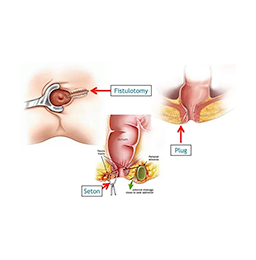What is Fistula ?
Treatment for a fistula depends on the type, location, cause, and severity. A fistula is an abnormal connection between two body parts, such as between an organ and the skin or between two organs. Here are common types and treatment approaches:
Anal Fistula (most common type)
Treatment Options:
- Fistulotomy : Most common; cutting open the fistula to allow it to heal from the inside out.
- Seton placement : Surgical thread is placed in the fistula to keep it open and allow drainage.
- Advancement flap surgery : Used for complex or high fistulas.
- Fibrin glue or plugs : Less invasive, but lower success rates.
- LIFT procedure (Ligation of Intersphincteric Fistula Tract) : Preserves sphincter muscles.
Rectovaginal Fistula
Treatment:
- Medical management : If Crohn’s-related, anti-inflammatory or biologic drugs may help.
- Surgical repair : May involve tissue flaps or direct closure of the tract.
Enterocutaneous Fistula (Bowel to Skin)
- Nutritional support : Often with total parenteral nutrition (TPN)
- Control infection : Antibiotics and drainage
- Surgery : Once the patient is stable and inflammation subsides
General Considerations
- Antibiotics : If there is infection.
- Imaging : MRI, CT, or ultrasound may be needed to map the fistula.
- Lifestyle and diet modifications : Especially in gastrointestinal-related fistulas.

